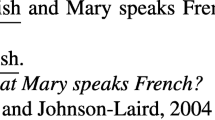Summary
The three experiments reported in this article are concerned with moderating conditions of the so-called conjunction fallacy. Although the conjunction of two events (A&B) is necessarily less probable than one event alone, intelligent people's judgments sometimes violate this logical principle when it is easier to think about or imagine the conjunction A&B than the component event A. It was hypothesized that the fallacy might be reduced either by a priming treatment (directing the participants' attention to the logical rule prior to the conjunctions tasks) or by a linguistic manipulation (replacing the ambiguous term “probability” by the term “frequency”. Experiment 1 shows that the bias is drastically reduced by the subtle linguistic manipulation and suggests that the fallacy is partly due to a common misunderstanding of the probability concept. The lack of a priming effect seems to imply that cueing or activation of logical schemata is not a critical factor. Experiment 2 replicates the linguistic influence under slightly modified task conditions, and Experiment 3 corroborates the ineffectiveness of the priming factor using a stronger priming treatment.
Similar content being viewed by others
References
Crocker, J. (1982). Biased questions in judgement covariation of studies. Personality and Social Psychology Bulletin, 8, 214–220.
Fiedler, K., & Stroehm, W. (1986). The use of statistical, spatialtemporal, and intensional information in judgments of contingency. European Journal of Social Psychology, 16, 385–398.
Kahneman, D., & Tversky, A. (1972). Subjective probability: A judgement of representativeness. Cognitive Psychology, 3, 430–454.
Kahneman, D., & Tversky, A. (1982). The simulation heuristic. In D. Kahneman, P. Slovic, & A. Tversky (Eds.) Judgement under uncertainty: Heuristics and biases. New York: Cambridge University Press.
Morier, D. M., & Borgida, E. (1984). The conjunction fallacy: A task specific phenomenon? Personality and Social Psychology Bulletin, 10, 243–252.
Thüring, M., & Jungerman, H. (1987). Whatever may cause conjunction fallacies: Probably not causality. Paper presented at the 11th Research Conference on Subjective Probability, Utility, and Decision Making, Cambridge, England.
Tversky, A., & Kahneman, D. (1983). Extensional versus intuitive reasoning: The conjunction fallacy in probability judgement. Psychological Review, 90, 293–315.
Yates, J. F., & Carlson, B. W. (1986). Conjunction errors: Evidence for multiple judgement procedures, including “signed summation”. Organizational Behavior and Human Decision Processes, 37, 230–253.
Author information
Authors and Affiliations
Rights and permissions
About this article
Cite this article
Fiedler, K. The dependence of the conjunction fallacy on subtle linguistic factors. Psychol. Res 50, 123–129 (1988). https://doi.org/10.1007/BF00309212
Received:
Issue Date:
DOI: https://doi.org/10.1007/BF00309212




